Visa Payments, (Truly) Mobile With Fitbit’s Ionic Smartwatch

Fitbit is debuting its Ionic watch – enabled for Visa payments. And, as noted Monday by the two companies, and as the data shows in the latest joint “How We Will Pay” study by Visa and PYMNTS, the timing is right for truly mobile payments experience, worn on the wrist.
Visa said
Fitbit announced Monday (Aug. 28) it is enabling Visa payments across its first smartwatch, the Fitbit Ionic.
In an announcement, Fitbit and Visa explained payments will be made through the Visa Token Service, which uses a unique digital identifier in lieu of the data that would traditionally span cardholder information, such as account numbers and card expiration dates.
“Visa continues to focus on delivering the tools and technologies that empower our partners to offer safe, secure and convenient payments to consumers via connected devices,” said Jim McCarthy, executive vice president of innovation and strategic partnerships at Visa in the news release. “Partnering with Fitbit on its new Fitbit Pay service is another step forward in the growth of [the] Internet of Things and shows how Visa is enabling companies across the technology industry to help us all move [toward] a cashless future.”
In terms of process, users load their Visa debit or credit cards into the Fitbit mobile app. Fitbit owners then complete transactions by holding the Ionic smartwatch near a near field communication (NFC)-enabled terminal.
The timing is right, according to data issued jointly from the card giant and PYMNTS.com, which found in a comprehensive study of nearly 2,600 consumers — How We Will Pay: Deep Dive into Wearables — that adoption of these devices has is becoming ever more pervasive.
Overall, those who own wearables are more inclined to embrace technology and hardware across the connected device spectrum. The joint study found consumers who own wearables own more devices than those who do not own wearables, with 5.5 connected devices owned versus 3.2 devices across the two groups. Of that tally, more than 20 percent of wearable device owners have voice-controlled assistants such as Amazon Alexa, while the percentage shrinks to the mid-single digits for non-wearable technology owners.
And the consumers who do own wearable technology tend to buy more items across a broad range of categories — from clothing to medication — than do those lacking in wearable devices. Perhaps not surprisingly, the consumers who own wearables tend to buy more things online than peers, at roughly 45 percent versus a respective 40 percent.
One conduit to increased transactions may be the wearable devices themselves, as 85 percent of those surveyed said reducing friction at the point of sale was a key reason to pay via connected device. Time and efficiency were also key concerns. As for data privacy, which worries more than 70 percent of wearables-owning respondents, Visa said Monday that tokenized service provides additional measures of safety and security.
Both groups may be signaling a shift away from hard currency, as the results from Visa and PYMNTS show more than 60 percent of all respondents prefer to use cards over cash. More than 28 percent of wearable device owners say they never use cash, significantly outpacing the 23.5 percent of those without wearable devices who say they never use cash.
